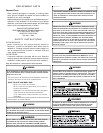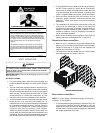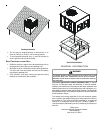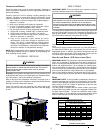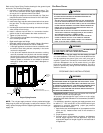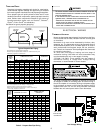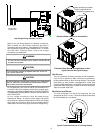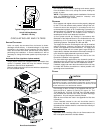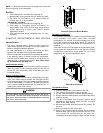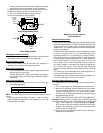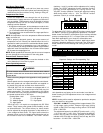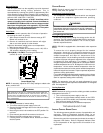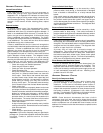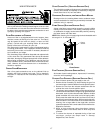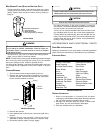
11
VENTING
NOTE: Venting is self-contained. Do not modify or block.
FLUE H OOD INSTALLATION
Install the flue hood and bug screen prior to operation of the
unit.
To install the flue hood cover and bug screen:
1. Remove the flue hood and bug screen from inside the
heat exchanger compartment.
2. Slide the bug screen over the flanges of the flue hood and
attach the flue hood and screen to the unit with the sheet
metal screws provided.
Flue Hood and Bug Screen Installation
CONDENSATE DRAIN
CONDENSATE D RAIN C ONNECTION
A 3/4” NPT drain connection is supplied for condensate piping. An
external trap must be installed for proper condensate drainage.
DRAIN
CONNECTION
UNIT 2" MINIMUM
FLEXIBLE
TUBING-HOSE
OR PIPE
3" MINIMUM
A POSITIVE LIQUID
SEAL IS REQUIRED
Drain Connection
NORMAL SEQUENCES OF OPERATION
HEATING
This unit is equipped with an ignition control that automatically
lights the main burner. DO NOT attempt to light the main
burners by any other method.
1. Thermostat calls for heat. The induced draft blower
energizes for a 15-second pre-purge.
2. The spark igniter and gas valve energizes for 7 seconds.
NOTE: The igniter produces a very intense electrical spark
that ignites the gas.
3. The 30-second HEAT FAN ON delay time begins.
*PG13(48,60)***1A ONLY: Heat on delay begins when
thermostat calls for heat. ECM motor is energized
approximately 45 seconds later. NOTE: ECM motor may
operate at approximately 100 CFM or less during the 45
second on delay period. ECM motor will energize at heating
speed after the 45 second delay regardless of the status
of the main burner flame.
4. The unit delivers heat to the conditioned space until the
thermostat is satisfied.
5. The gas valve deenergizes. The induced draft blower
continues operation for a 29-second post-purge.
6. Ignition control begins timing the HEAT FAN OFF delay.
There is an adjustable HEAT FAN OFF delay of
approximately 120/135/150 seconds (factory set at 150).
After the HEAT FAN OFF delay time has elapsed, the blower
will deenergize. This allows any additional heat in the
heat exchanger to be transferred to the conditioned space.
*PG13(48,60)***1A ONLY: HEAT FAN OFF delay is fixed at
180 seconds. Airflow level is 50% of nominal heating
airflow.
COOLING
1. Thermostat calls for cooling. The compressor and outdoor
fan are energized.
2. Approximately seven seconds later, the indoor fan starts.
3. The unit will deliver cooling to the conditioned space until
the thermostat is satisfied.
4. The compressor and outdoor fan will be deenergized when
the thermostat opens.
5. The indoor fan continues to run for approximately 60
seconds after the thermostat is satisfied. This allows
additional cooling from the indoor coil to be transferred to
the conditioned space. Then, the indoor fan stops.
*PG1348***1A ONLY:
1. Thermostat calls for cooling. Outdoor fan and compressor
are energized. ECM motor is energized almost immediately
for 30 seconds at 50% of the nominal airflow. Airflow then
increases to nominal airflow.
2. The unit will deliver cooling to the conditioned space until
thermostat is statisfied.
3. The outdoor fan and compressor will be de-energized when
thermostat opens.
4. ECM motor continues to operate for approximately 60
seconds at 50% of nominal airflow after thermostat opens.
*PG1360***1A ONLY:
1. Thermostat calls for low stage cooling. Outdoor fan and
low stage compressor are energized. ECM motor is
energized almost immediately for 30 seconds at 50% of
the nominal low stage airflow. Airflow then increases to
nominal low stage airflow.
If thermostat calls for high stage cooling, outdoor fan and
low and high stage compressor is energized. ECM motor is
energized almost immediately for 30 seconds at 50% of
the nominal high stage airflow. Airflow then increases to
nominal high stage airflow.
2. The unit will deliver cooling to the conditioned space until
thermostat is satisfied.
3. The outdoor fan and low stage compressor (or low and high
stage compressor) will be de-energized when thermostat
opens.
4. ECM motor continues to operate for approximately 60
seconds at 50% of nominal low stage airflow (or high
stage airflow if thermostat call was for high stage cooling)
after thermostat opens.



